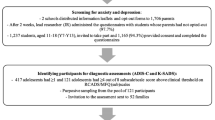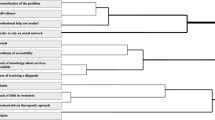Abstract
Background
Although depression is common amongst adolescents attending general practice, little is known about factors which influence consultation. This study aims to identify factors that contribute to GP attendance in adolescents with high levels of mood symptoms.
Methods
Case–control study of 13 to 17-year-olds attending (cases, N = 156) and not attending (controls, N = 120) an urban general practice during a 6-month period; questionnaires on depressive symptoms (Mood and Feelings Questionnaire), physical symptoms (Child Somatisation Inventory), socio-demographic data and attitudes were completed.
Results
Attenders had significantly more depressive and physical symptoms. In the comparison between 63 attenders and 34 non-attenders with a high level of depressive symptoms, attendance was significantly linked to lower socio-economic status, non-White ethnicity, non-intact families, and not believing that doctors are only interested in physical symptoms. On logistic regression analysis, attendance in males with depressive symptoms was predicted by more physical and less marked depressive symptoms; in females by non-White ethnicity and not believing doctors are only interested in physical symptoms.
Conclusion
Both socio-demographic factors and adolescent attitudes influence general practitioner attendance in adolescents with high levels of depressive symptoms. These findings may help inform interventions to facilitate help seeking in primary care for young people with high levels of depressive symptoms.

Similar content being viewed by others
References
Angold A, Weissmann MM, Merikangas KR, Prusoff P, Wickramaratne G, Gammon GD, Warner V (1987) Parent and child reports of depressive symptoms in children at low and high risk of depression. J Child Psychol Psychiatry 28:901–915
Asarnow JR, Jaycox LH, Duan N, LaBorde AP, Rea MM et al (2005) Depression and role impairment among adolescents in primary care clinics. J Adolesc Health 37:477–483
Arsanow JR, Jaycox LH, Duan N, LaBorde AP, Rea MM et al (2005) Effectiveness of a quality improvement intervention for adolescent depression in primary care. A randomized control trial. J Am Med Assoc 293:311–319
Bowman FM, Garralda ME (1993) Psychiatric morbidity among children who are frequent attenders in general practice. Br J Gen Pract 43:6–9
Burns JJ, Cottrell L, Perkins K, Pack R, Stanon B et al (2004) Depressive symptoms and health risk among rural adolescents. Pediatrics 113:1313–1320
Colman I, Wadsworth MEJ, Croudace TJ, Jones PB (2007) Forty-year psychiatric outcomes following assessment for internalizing disorders in adolescence. Am J Psychiatry 164:126–133
Cooper PJ, Goodyer I (1993) A community study of depression in adolescent girls. I: Estimates of symptom and syndrome prevalence. Br J Psychiatry 163:369–374
Costello E, Angold A, Burns B, Erkanli A, Stangl DK et al (1996) The Great Smoky Mountains Study of Youth; functional impairment and serious emotional disturbance. Arch Gen Psychiatry 53:1137–1143
Dunn V, Goodyer IM (2006) Longitudinal investigation into childhood and adolescence onset depression: psychiatric outcome in early adulthood. Br J Psychiatry 188:216–222
Essau CA (2007) Course and outcome of major depressive disorder in non-referred adolescents. J Affect Disord 99:191–201
Ford T, Goodman R, Meltzer H (2003) The British Child and Adolescent Mental Health Survey 1999: the prevalence of DSM-IV disorders. J Am Acad Child Adolesc Psychiatry 42:1203–1211
Fröjd S, Narttunen M, Pelkonen M, von der Pahlen B, Kaltiala-Heino R (2007) Adult and peer involvement in help-seeking for depression in adolescent population. A two-year follow-up in Finland. Soc Psychiatry Psychiatr Epidemiol 42:945–952
Garber J, Walker L, Zeman J (1991) Somatization symptoms in a community sample of children and adolescents: further validation of the children’s somatisation inventory. J Consult Clin Psychol 3:588–595
Gledhill J, Kramer T, Iliffe S, Garralda ME (2003) Training general practitioners in the identification and management of adolescent depression within the consultation: a feasibility study. J Adolesc 26:245–250
Harrington R, Fudge H, Rutter M, Pickles A, Hill J (1990) Adult outcomes of child and adolescent depression. I. Psychiatric status. Arch Gen Psychiatry 47:465–473
Jorm AF, Wright A, Morgan AJ (2007) Where to seek help for a mental disorder? National survey of the beliefs of Australian youth and their parents. Med J Aust 187:556–560
Kramer T, Iliffe S, Murray E, Waterman S (1997) Which adolescents attend the GP? Br J Gen Pract 47:327
Kramer T, Garralda ME (1998) Psychiatric disorders in adolescents in primary care. Br J Psychiatry 173:508–513
Lewinsohn PM, Hops H, Roberts RE, Seeley JR, Andrews JA (1993) Adolescent psychopathology. I: Prevalence and incidence of depression and other DSM-III-R disorders in high school students. J Abnorm Psychol 102:133–134
Lewinsohn PM, Rhode P, Klein DN, Seeley JR (1999) Natural course of adolescent major depressive disorder. I: Continuity into young adulthood. J Am Acad Child Adolesc Psychiatry 38:56–63
Martinez R, Reynolds S, Howe A (2006) Factors that influence the detection of psychological problems in adolescents attending general practices. Br J Gen Pract 56:594–599
National Institute for Health and Clinical Excellence NICE (2005) Depression in children and young people. http://guidance.nice.org.uk/CG28/niceguidance/pdf/English
Office of Population Censuses and Surveys (1980) Classification of occupations. Her Majesty Stationery Office, London
Offord DR, Boyle MH, Szatmari P, Rae-Grant NI, Links PS et al (1987) Ontario Child Health Study. II. Six month prevalence of disorder and rates of service utilization. Arch Gen Psychiatry 44:832–836
Pelkonen M, Marttunen M, Aro H (2003) Risk for depression: a 6-year follow-up of Finnish adolescents. J Affect Disord 77:41–51
Prince M, Stewart R, Ford T, Hotopf M (2003) Practical psychiatric epidemiology. Oxford University Press, New York, p 28
Rao U, Hammen C, Daley S (1999) Continuity of depression during the transition to adulthood: a 5-year longitudinal study of young women. J Am Acad Child Adolesc Psychiatry 38:908–915
Read JD (1990) Royal College of general practitioners members reference book. RCGP, London
Robson J, Falshaw M (1995) Audit of preventive activities in 16 inner London practices using a validated measure of patient population, the ‘active patient’ denominator. Br J Gen Pract 45:463–466
Sen B (2004) Adolescent propensity for depressed mood and help seeking: race and gender differences. J Ment Health Policy Econ 7:133–145
Weissman MM, Wolk S, Goldstein RB, Moreau D, Adams P et al (1999) Depressed adolescents grown up. J Am Med Assoc 281:1707–1713
Wood A, Kroll L, Moore A, Harrington R (1995) Properties of the Mood and Feelings Questionnaire in adolescent psychiatric outpatients: a research note. J Child Psychol Psychiatry 36:327–334
Yates P, Kramer T, Garralda ME (2004) Depressive symptoms amongst adolescents primary care attenders. Levels and associations. Soc Psychiatry Psychiatr Epidemiol 39:588–594
Zuckerbrot RA, Jensen PS (2006) Improving recognition of adolescent depression in primary care. Arch Pediatr Adolesc Med 160:694–704
Acknowledgments
We would like to thank the GPs, adolescents and families who participated in the study. We are grateful to Dr. Emma Sedgwick for her help with data collection, to Daniel Stahl for statistical advice, and to Dr. Miguel Ruiz-Veguilla for his helpful comments.
Conflict of interest statement
Dr. Ferrin is partially supported by grants from the Instituto de Salud Carlos III (Plan Nacional I+D+I 2007) and from the Fundacion Alicia Koplowitz. No other conflicts declared.
Author information
Authors and Affiliations
Corresponding author
Rights and permissions
About this article
Cite this article
Ferrin, M., Gledhill, J., Kramer, T. et al. Factors influencing primary care attendance in adolescents with high levels of depressive symptoms. Soc Psychiat Epidemiol 44, 825–833 (2009). https://doi.org/10.1007/s00127-009-0004-x
Received:
Accepted:
Published:
Issue Date:
DOI: https://doi.org/10.1007/s00127-009-0004-x




